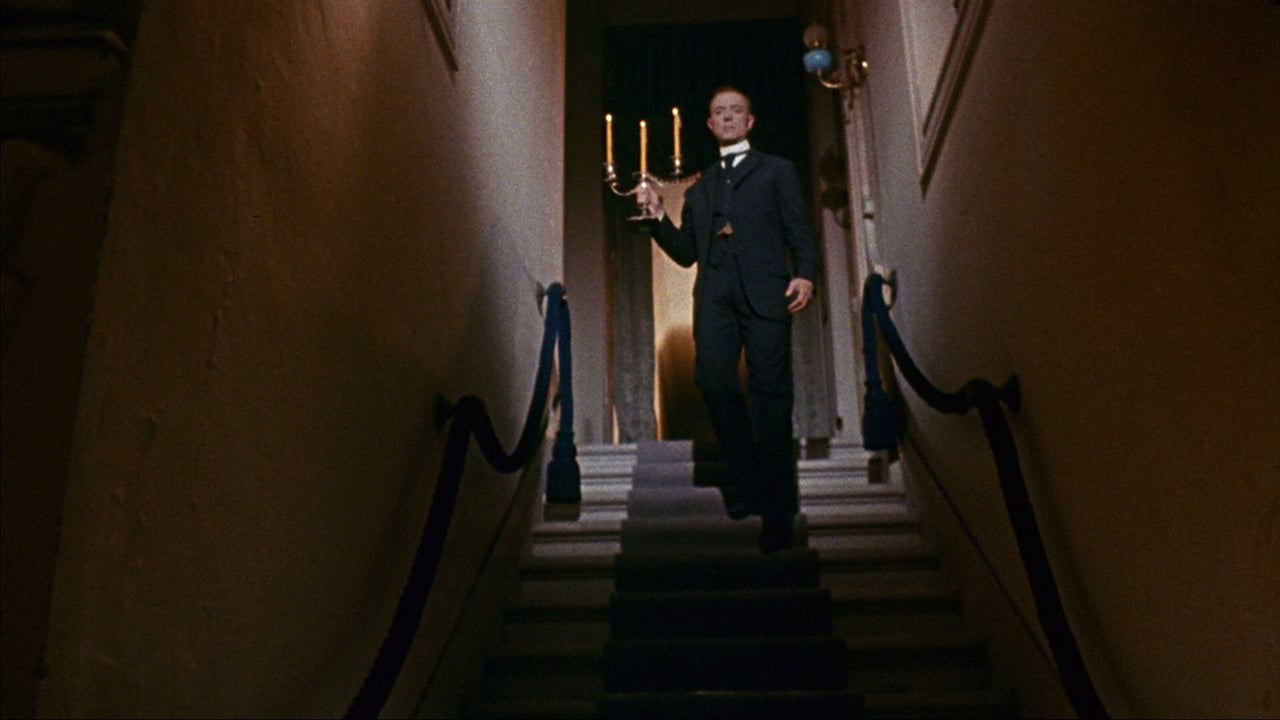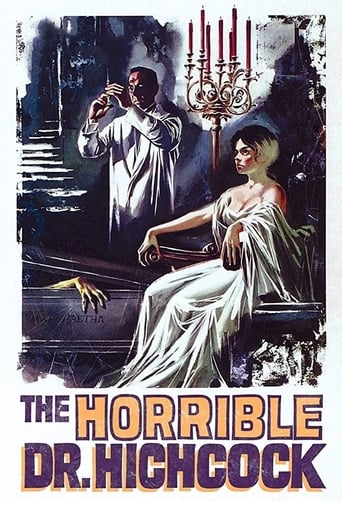

ridiculous rating
... View MoreOne of the worst movies I've ever seen
... View MoreA waste of 90 minutes of my life
... View MoreI think this is a new genre that they're all sort of working their way through it and haven't got all the kinks worked out yet but it's a genre that works for me.
... View MoreA pretty wild ride, this one, after a rather uncomfortable and disturbing start as the first coffin is interfered with. Robert Flemyng is effective as the horrible doctor but I bet he used to leave this one off his CV. Between the worrying start and the breakneck finale there is really not that much happening but we are sustained by the grisly nature of the goings on, majestic photography and, of course, the equally majestic, Barbara Steele. I read somewhere that it was reckoned this was Steele's greatest performance and, on reflection, I think that may be so. Certainly she has a lot to do and continually looks as worried as she is beautiful. Strangely, her two most impressive scenes are both shot through glass. There is a terrifying moment when she and we see a ghost in the garden, through her window and then towards the end the amazing shots of her in the coffin through the small glass window. Not a great story but this works from beginning to end, nevertheless.
... View MoreBefore having read anything about Italian Gothic Horror films,my original through when hearing about this title a few years ago was that it must be some sort of comedy film about Alfred Hitchcock!.As time went on,and I eventually got round to finding out a few things about this particular Italian cinema sub-genre,this title seemed to be one of the main three which are connected to the sub-genre.Searching round on Youtube,I ended up finding a subtitled video of the film where all of the colour looked like it had been covered in oil.Getting very keen on seeing the film in its full "glory",I went on a frantic search until I found a beautiful bright dubbed print of the film,which at last gave me a chance to book an appointment with the good doctor..The plot: Wanting to make the relationship that he has with his wife (Margherita Hichcock) a bit more kinky,Doctor Bernard Hichcock decides to try a chemical that will cause his wife's heartbeat to drop to a level that will cause her to look like a corpse.Shortly after giving her the injection,Hichcock discovers that seeing the effect of the chemical on his wife,helps him to reach a level of "excitement" that Bernard has never imagined.Sadly,along with the excitement Hichcock discovers a little too late that the chemical has a terrible side-effect when his wife suddenly stops "pretending" and actually becomes a corpse.Despite having a long struggle to get over the death of his wife,Hichcock meets a woman called Cynthia who he soon proposes to.After getting married to the woman,Hichcock takes her back to his mansion,where they will spend the rest of their lives happily together.How ever,although Hichcock is doing everything to help his new wife "settle in",Cynthia begins to suspect that he is trying to hide something about his past when she first notices that his mansion is covered with paintings of his deceased wife and that she is perhaps starting to see things,due to having looked out of a window,and seeing what looked to be "a ghostly,living corpse" outside the mansion.View on the film:Despite the films screenplay disappointingly not reaching my expectation levels director Ricardo Fredra gives the movie a terrific, almost twisted Brothers Grimm like appearance with his stylish directing,which brilliantly makes the film's locations look like actually interiors and not scenes that were shot in a studio thanks to Fredra making the characters long shadows a prominent feature to the look of the film.Also with the shadows Ricardo uses the Technicolor format in a fantastic eye- catching manner,as the characters faces and the castle location are brought to life in a stunningly lit up shiny style.Along with Fredra's solid directing the film also features a great performance from lead actress Barbara Steele (who interestingly,is an uncredited extra in the 1959 Alfred Hitchcock film The 39 Steps and also starred in the 1961 Alfred Hitchcock Presents episode titled Beta Delta Gamma shortly before making this film!) who along with looking beautifully striking also does brilliantly at showing the wide-eyed fear that Cynthia starts to develop as she begins to wonder if her husband (played by a wonderfully stern Robert Flemming)is attempting to hide something extremely disturbing from her,or if she is actually starting to lose a grip on her sanity.Sadly with the great work that Freda and Steele display in this film,the screenplay by Ernesto Gastaldi (who also wrote the Sergio Martino Giallo All The Colours Of The Dark) deflates any feeling of terror for the first hour of what should be a very nerve- wrecking film,due to Gastaldi making the pace of the films plot move at a surprisingly slow pace,which despite the last half an hour of the movie feeling pretty energetic leaves the overall film feeling disappointing and tied. Final view on the film: Terrific stylish directing from Freda and a great performance from Steele are sadly let down by a disappointingly plodding screenplay.
... View MoreEnticing, beautiful and absorbingly atmospheric Italian Gothic horror film from the absolute golden period, the early 60's, and starring one of the world's most radiantly gorgeous female creatures; Barbara Steele. "The Terrible Secret of Dr. Hichcock" - notice there's no "T" in the name to avoid lawsuits against the master of suspense himself – takes place in London in the year 1885, at the peak of the Victorian era in other words, and certainly contains all the necessary ingredients of a delicious Gothic cocktail, but unfortunately the film is a bit slow-moving and it takes slightly too long before something really substantial occurs. Director Riccardo Freda generates a compelling and ultra-macabre Gothic atmosphere, with numerous thunderstorms and dark château passageways, but he doesn't have a fascinating enough plot to go with the ambiance. Usually writer Ernesto Gastaldi punctually delivers engaging and superb scenarios, but maybe this time he seemingly had a bit of an off-day. After his wife dies from a mysterious condition, which he may or may not have inflicted himself, Dr. Hichcock promptly leaves his mansion and prominent job at the hospital. He returns twelve years later with an even lovelier new wife (Mrs. Steele!) Cynthia and reprises his profession. During her many dull days alone in the mansion, Cynthia notices a sinister presence and it doesn't take too long before she starts losing her mind further on. She suffers from horribly nightmarish hallucinations in which she hears disturbing screams and spots Dr. Hichcock's previous wife meander through the house and nearby woods completely covered in a white ghostly nightgown. Is her mental condition really deteriorating or could it be that the good Doctor's first wife never really passed away? I think the title alone already answers this haunting question. Overall a very derivative and forgettable story but, as said, it are the spooky atmosphere and Victorian elements that'll keep you alert in this movie. The decors are stunning and the black-and-white photography is stylishly elegant. If you've never seen this type of movie before, "The Terrible Secret of Dr. Hichchock" perhaps isn't the ideal place to start, but experienced horror fanatics will certainly appreciate spotting all the luscious trademarks.Riccardo Freda actually was the mentor of the greatest Italian horror director who ever lived; Mario Bava. Freda took a step sideways on the film sets of "I, Vampire" and "Caltiki"; offering Bava a chance to complete his first films as director as well next to being the cinematographer. I always wondered whether or not Freda ever regretted this initiative, because from the very first moment the acolyte surpassed his mentor in terms of pure and genuine craftsmanship. For example this "The Terrible Secret of Dr. Hichckock" is a nice and worthwhile Gothic horror installment, but it undeniably can't hold a candle to Bava's "Black Sunday" (also starring Barbara Steele) or "The Whip and the Body".
... View MoreTHE TERROR OF DR.HICHCOCK (L'ORRIBILE SEGRETO DEL DR.HICHCOCK is a masterpiece! It seems I have come to appreciate this picture more with each viewing. Whereas NIGHTMARE CASTLE is focused on generating an atmosphere of ugliness and treachery capped with a satisfying supernatural pay-off, HICHCOCK goes for more and immerses the viewer in a suffocating fog of loathsomeness and horror. Robert Flemyng as Bernard Hichcock is marvelous. He perfectly calibrates his performance so as to expose his character's slow descent into unbridled derangement. The film opens with Hichcock practicing necrophilia, but we soon see that the Doctor, while obviously demented, is quite capable of protecting the secret of his awful desires. But, as the story unfolds, it becomes apparent that his abominable passions are slowly overtaking his intellect and his ability to maintain the appearance of normality. Much of the film's horror stems from this powerful presentation of the insidious and irresistibly intensifying nature of sexual psychosis. It also seems this film holds the ultimate moment of horror in Barbara Steele's exceptional career as a genre actress. The scene as her character, Cynthia, wakes from a drugged sleep is stunning. Cynthia finds herself strapped to a cot and watches as her husband materializes out of the darkness and menacingly advances upon her. To her full horror she stares wide-eyed as Hichcock's face distorts into a misshapen, glowing red mask of malignancy and evil. This magnificent shot was achieved with the use of surrealistic, nightmarish lighting and facial bladders attached to Flemyng's face, which, as they were slowly inflated, dreadfully perverted the actor's features.One of the major contributing factors to this film's impact is the sumptuous score by Roman Vlad. Vlad produced a lush tapestry of fully-formed themes and motifs. Most noticeable is the superb piano concerto elegantly performed by Hichcock's first wife, the ill-fated Margherita Hichcock. Simultaneously beautiful and unsettling, I have no qualms about favorably comparing Vlad's fine effort with that other exalted "gothic horror film" composition for solo piano, James Bernard's Vampire Rhapsody from KISS OF THE VAMPIRE. Vlad also composed what I will call Hichcock's Theme; a superlative example of emblematic impressionism. The piece effectively advances a fresh orchestral paraphrase for things dark and depraved, and does so without being prosaic or overwrought. Oddly, Vlad refrained from employing any of these principal themes in the opening titles. THE TERROR OF DR.HICHCOCK is just as shocking today as it was 40 years ago. Don't miss it!
... View More